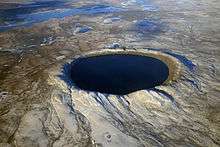Beaverhead crater
The Beaverhead crater is an impact structure spanning the U.S. states of Idaho and Montana. Estimated at 60 kilometers (37 mi) in diameter, it is one of the largest impact craters on Earth.
 Beaverhead crater Location of Beaverhead crater in Idaho | |
| Impact crater/structure | |
|---|---|
| Confidence | confirmed [1] |
| Diameter | 60 kilometres (37 mi) |
| Age | 600 million years |
| Exposed | Yes |
| Drilled | No |
| Location | |
| Coordinates | 44°36′N 113°0′W |
| Country | United States |
| State | Idaho, Montana |
With an estimated age of 600 million years (Neoproterozoic), the impact's original shatter cones along the crater's perimeter provide some of the structure's only remaining visible evidence.
It is named for the Beaverhead region of southwestern Montana in which it was first discovered.
References
- "Beaverhead". Earth Impact Database. Planetary and Space Science Centre University of New Brunswick Fredericton. Retrieved 2015-01-02.
Further reading
- Carr, J and Link, PK, 1999, Neoproterozoic conglomerate and breccia in the formation of Leaton Gulch, Grouse Peak, northern Lost River Range, Idaho: Relation to Beaverhead Impact Structure, in Hughes, S.S., and Thackray, G.D., eds., Guidebook to the Geology of Eastern Idaho: Pocatello, Idaho Museum of natural History, p. 21-29.
- Aerial Exploration of the Beaverhead crater
This article is issued from Wikipedia. The text is licensed under Creative Commons - Attribution - Sharealike. Additional terms may apply for the media files.

